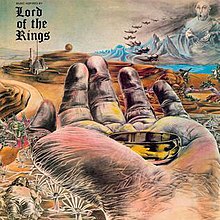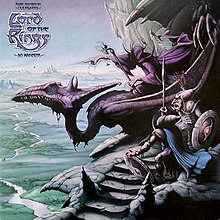
Bo Hansson was a Swedish musician best known for his four instrumental progressive rock studio albums released throughout the 1970s.

Waterloo is the second studio album by the Swedish pop group ABBA, and the first released internationally. It was originally released on 4 March 1974 in Sweden through Polar Music. The album's title track won ABBA the 1974 Eurovision Song Contest and became a global hit, launching the group's career.

Genesis Live is the first live album from the English rock band Genesis, released on 20 July 1973 on Charisma Records. Initially recorded for radio broadcast on the American rock program King Biscuit Flower Hour, the album is formed from the recordings of shows at Free Trade Hall, Manchester and De Montfort Hall, Leicester in February 1973 during the band's tour supporting their fourth studio album Foxtrot (1972).
The works of J. R. R. Tolkien have served as the inspiration to painters, musicians, film-makers and writers, to such an extent that he is sometimes seen as the "father" of the entire genre of high fantasy.
Do not laugh! But once upon a time I had a mind to make a body of more or less connected legend, ranging from the large and cosmogonic to the level of romantic fairy-story... The cycles should be linked to a majestic whole, and yet leave scope for other minds and hands, wielding paint and music and drama. Absurd.

"Namárië" is a poem by J. R. R. Tolkien written in one of his constructed languages, Quenya, and published in The Lord of the Rings. It is subtitled "Galadriel's Lament in Lórien", which in Quenya is Altariello nainië Lóriendessë. The poem appears, too, in a book of musical settings by Donald Swann of songs from Middle-earth, The Road Goes Ever On; the Gregorian plainsong-like melody was hummed to Swann by Tolkien. The poem is the longest Quenya text in The Lord of the Rings and also one of the longest continuous texts in Quenya that Tolkien ever wrote. An English translation is provided in the book.

The discography of Swedish pop music group ABBA consists of nine studio albums, two live albums, seven compilation albums, four box sets, five video albums, 50 singles, and 43 music videos. To date, ABBA have sold more than 150 million records worldwide becoming one of the best-selling music artists in history. They have scored 9 No. 1 singles and 10 No. 1 albums in the UK, becoming the most successful Swedish act of all time on the Official Charts.

"Ramble On" is a song by the English rock band Led Zeppelin. Co-written by Jimmy Page and Robert Plant and produced by Page, and recorded in 1969 at Juggy Sound Studio, New York City and A & R Recording, Manhattan, it serves as the seventh track of their second studio album Led Zeppelin II. The song's lyrics were influenced by J. R. R. Tolkien's fantasy novel The Lord of the Rings.

The discography of Nirvana, an American rock band, consists of three studio albums, twenty-one singles, five live albums, two extended plays, four compilation albums, and three box sets.

The discography of the British band Genesis contains 15 studio albums, 6 live albums, 3 compilation albums, and 10 box sets. They have sold over 100 million albums worldwide, including around 21.5 million RIAA-certified albums in the United States

Simon & Garfunkel, an American singer-songwriter duo, has released five studio albums, fifteen compilation albums, four live albums, one extended play, twenty-six singles, one soundtrack, and four box sets since 1964. Paul Simon and Art Garfunkel first formed a duo in 1957 as Tom & Jerry, before separating and later reforming as Simon & Garfunkel.
Many adaptations of The Lord of the Rings, an epic by the English author J. R. R. Tolkien, have been made in the media of film, radio, theatre, video games and recorded readings.
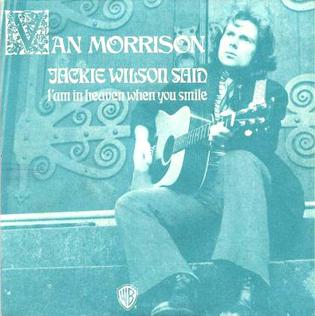
"Jackie Wilson Said (I'm in Heaven When You Smile)" is a song written and performed by Van Morrison and featured as the opening track on his sixth studio album, Saint Dominic's Preview. It was released by Warner Bros. in July 1972 as the first of three singles from the album and charted at number sixty-one on the US Billboard Hot 100. Both the music and lyrics are inspired by rhythm and blues singer Jackie Wilson and his song "Reet Petite", which is directly quoted in the song.

Symphony No. 1 The Lord of the Rings is the first symphony for concert band written by Johan de Meij, and one of several works of classical music based on J. R. R. Tolkien's fantasy The Lord of the Rings. It premiered in 1988 with the Groot Harmonieorkest van de Belgische Gidsen conducted by Norbert Nozy.

Magician's Hat is an instrumental progressive rock album by Swedish musician Bo Hansson. It is his second solo album, following the successful Music Inspired by Lord of the Rings, and was originally released in Sweden by Silence Records in 1972, with the title Ur trollkarlens hatt.
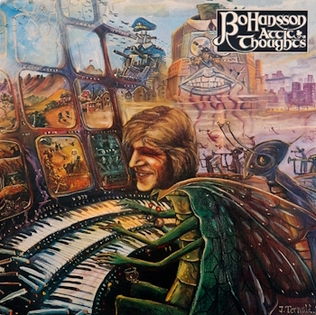
Attic Thoughts is a 1975 instrumental progressive rock album by Swedish musician Bo Hansson.

Music Inspired by Watership Down is a 1977 progressive rock album by Swedish musician Bo Hansson. The album is Hansson's fourth solo album and is, as its name suggests, built around musical ideas inspired by Richard Adams' heroic fantasy novel Watership Down.
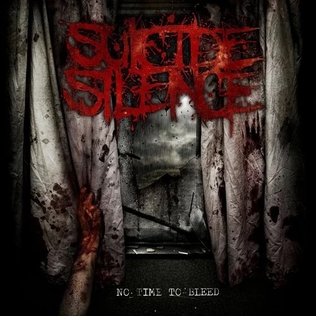
No Time to Bleed is the second studio album by American deathcore band Suicide Silence. It was released on June 30, 2009 through Century Media Records. The album was released in five different editions; the standard version, the Exclusive Hot Topic Edition, the iTunes edition, the vinyl edition, and the Maximum Bloodshed Edition. Upon its release, it debuted at number 32 on the Billboard 200, selling 14,001 copies in the United States alone. It is Suicide Silence's most critically acclaimed album and was re-released as No Time to Bleed: Body Bag Edition on July 1, 2010, little over a year after the record's original pressing. No Time to Bleed is also the first release to feature bassist Dan Kenny.
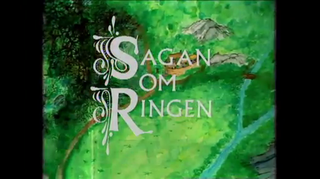
Sagan om ringen is a 1971 Swedish live action television film in two episodes. The film was inspired by the music album Music Inspired by Lord of the Rings by Bo Hansson, which in turn was inspired by J. R. R. Tolkien's 1954 novel The Lord of the Rings.

Poems and Songs of Middle Earth is a studio album of spoken-word poetry by the English author J. R. R. Tolkien and art songs composed by the English musician Donald Swann. On the first half of the album, Tolkien recites seven poems from or related to his fantasy novel The Lord of the Rings (1954–55). The second half is a performance of Swann's song cycle The Road Goes Ever On, which sets selections from Tolkien's verse to music. The vocalist William Elvin sings The Road Goes Ever On to Swann's piano accompaniment. Caedmon Records issued the album on 18 October 1967 in the United States, and then on 28 March 1968 in the United Kingdom. Its release coincided with the publication of The Road Goes Ever On as a book of sheet music with commentary and illustration by Tolkien.

The music of Middle-earth consists of the music mentioned by J. R. R. Tolkien in his Middle-earth books, the music written by other artists to accompany performances of his work, whether individual songs or adaptations of his books for theatre, film, radio, and games, and music more generally inspired by his books.
